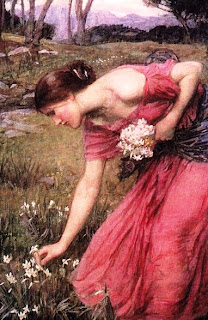
En... zijn zo'n narcissen ook nog ergens goed voor? Wel wat onbeschoft van mij om dat te vragen.
In King's American Dispensatory, 1898, geschreven door Harvey Wickes Felter, M.D., and John Uri Lloyd, Phr. M., Ph. D staat over Narcissus.....but is said to possess emetic, cathartic, antispasmodic, and narcotic properties. It has been used in epilepsy, in hysteria, and other spasmodic affections. Laennec employed it with success in pertussis, and other European practitioners have accorded to it an efficient action in intermittent fever, diarrhoea, dysentery, worms, etc. It has likewise been found of prompt benefit in severe catarrh. The cases for narcissus are those exhibiting epileptoid movements of the muscles, in chorea, in rheumatism, showing muscular contractions, and in cerebral diseases, with dull eyes and dilated pupils. A tincture of the bulbs by maceration in 98 per cent alcohol, may be given in doses of 1/4 drop to 10 drops. Dose of dried flowers or bulbs, in powder, from 10 to 60 grains; from 1 to 3 grains of the aqueous extract provokes vomiting. A syrup, ethereal oil, and acetous tincture have also been employed.
Professor Barger has given the following notes on the alkaloid of Narcissus Pseudo-narcissus. 'In 1910 Ewins obtained from the bulbs a crystalline alkaloid, to which he gave the name of narcissine, and on analysis found the formula to be C16H17ON.' He notes that the alkaloid is characterized by great stability and cannot easily be decomposed. Ringer and Morshead found the alkaloid from resting bulbs acted like pilocarpine, while that from the flowering bulbs resembled atropine. Laidlaw tested Ewins' alkaloid on frogs and cats, but found no action similar to pilocarpine or atropine. 0.125 gram given by mouth to a cat caused vomiting, salivation and purgation. In 1920 Asahtna, Professor of Chemistry in the Tokyo College of Pharmacy, showed that narcissine is identical with Iycorine isolated from Lycoris radiata in 1899. The name narcissine has therefore been dropped. Lycorine is quite common in the N.O. Amaryllidaceae. It was found in Buphane disticha by Tutin in the Mellome Research Laboratory in 1911 (Journ. Chem. Soc. Transactions 99, page 1,240). It is generally present in quite small quantities, at most 0.1 to 0.18 per cent of the fresh material. Chemically, Iycorine or narcissine has some resemblance to hydrastine, and like it, contains a dioxymethylene group.
En in A Modern Herbal (1931) van Mrs Grieve, zonder meer één van mijn oude lievelingsboeken, ook al omwille van de citaten uit nog oudere kruidenboeken (en zo blijven we maar citeren...)
---Medicinal Action and Uses---The following is a quotation from Culpepper:
 'Yellow Daffodils are under the dominion of Mars, and the roots thereof are hot and dry in the third degree. The roots boiled and taken in posset drink cause vomiting and are used with good success at the appearance of approaching agues, especially the tertian ague, which is frequently caught in the springtime. A plaster made of the roots with parched barley meal dissolves hard swellings and imposthumes, being applied thereto; the juice mingled with honey, frankincense wine, and myrrh, and dropped into the ears is good against the corrupt and running matter of the ears, the roots made hollow and boiled in oil help raw ribed heels; the juice of the root is good for the morphew and the discolouring of the skin.'
'Yellow Daffodils are under the dominion of Mars, and the roots thereof are hot and dry in the third degree. The roots boiled and taken in posset drink cause vomiting and are used with good success at the appearance of approaching agues, especially the tertian ague, which is frequently caught in the springtime. A plaster made of the roots with parched barley meal dissolves hard swellings and imposthumes, being applied thereto; the juice mingled with honey, frankincense wine, and myrrh, and dropped into the ears is good against the corrupt and running matter of the ears, the roots made hollow and boiled in oil help raw ribed heels; the juice of the root is good for the morphew and the discolouring of the skin.'It is said by Galen to have astringent properties. It has been used as an application to wounds. For hard imposthumes, for burns, for strained sinews, stiff or painful joints, and other local ailments, and for 'drawing forth thorns or stubs from any part of the body' it was highly esteemed.
The Daffodil was the basis of an ancient ointment called Narcissimum.
The powdered flowers have been used as an emetic in place of the bulbs, and in the form of infusion or syrup, in pulmonary catarrh.
---Poison and Antidotes---It may be noted that Henry states that Iycorine or narcissine in warm-blooded animals acts as an emetic causing eventually collapse and death by paralysis of the central nervous system.
There have been several cases of poisoning by Daffodil bulbs which have been eaten in mistake for onions. In one case the points observed were: the speedy action of the poison; the fact that the high temperature did not destroy the toxicity of the poison; and the relatively small quantity of Daffodil bulbs which caused the trouble.
Dus toch nog te veel informatie en het mag duidelijk zijn dat deze lieflijke bloem vooral 'om naar te kijken is'. Misschien moeten we het maar houden bij het verhaal van de mythische Narcissus, de zoon van de riviergod Cephisus. De nimf Echo wedijverde met vele andere nimfen om de gunsten van de jongeman. Helaas leek Narcissus niet in staat om ook maar iemand te beminnen. Echo nam deze afwijzing niet,: ze zorgde ervoor dat Narcissus verliefd werd op zijn eigen spiegelbeeld. De jongen kwijnde uiteindelijk helemaal weg omdat hij zijn spiegelbeeld niet kon bereiken. Op de plaats waar hij overleed ontsproot de pseudonarcissus uit de grond.

Geen opmerkingen:
Een reactie posten